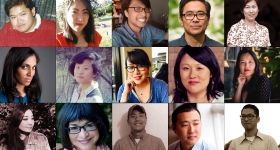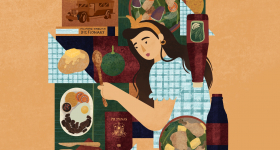I - Karachi
After the first one, they came every morning before school, like clockwork. I can only describe it as utter physiology: the insides churning and gyring, longing ravenously for a long-lost outside that my skin had separated ever since I tumbled into the world. It was distinctive, it had a signature. It wasn’t anything like the vomit you produce after, say, a food poisoning, where the stomach exerts its own tentative agency to warn you about a nasty intruder. It wasn’t just the insides pining for the outside; the outside, heavy and pendulous, sat gingerly on my pre-pubescent shoulders like an awful child demanding a piggy-back ride. Then it reached for the midriff and squeezed as tightly as possible, driving the stomach to purge its non-contents: mucus and acid. Needless to say, for a very long time I did not eat anything on school mornings, surviving until lunchtime on a breakfast of emesis.
**
Of course Sartre chose nausea as the paradigmatic symptom of existential angst. In La Nausée, he too recognized that “the Nausea is not inside me: I feel it out there in the wall … everywhere around me. It makes itself one with the café, I am the one who is within it.”
**
The mornings were somber affairs — I recall them now habitually in grayscale. I also recall them without any sound except the soft cooing of pigeons roosting in the balcony and the very slight beginnings of traffic on the main road, onto which the balcony opened like a promontory. Things happened in the mornings in a kind of haze, as if the household was wading underwater, too reluctant to leave the home and take on the day. I would imagine what mornings were like in other houses: did they all collect noisily in a well-lit dining room and eat a full breakfast, complete with eggs, toast and orange juice like in the American movies? Did the Dad read the newspaper while sipping on his coffee and then, after pecking the Mom ever so lightly on the cheek, leave the house with briefcase in hand?
My father wasn’t up until 9 am unless our driver (a classist fixture of many bourgeois homes in postcolonial South Asia, a remnant of British sahib culture) didn’t show on time, in which case he had to drive us to school. He’d emerge from my parents’ bedroom still in the shalwar kameez that he wore to bed, eyes puffy, curly wisps of hair still smudged together with mustard oil. But usually it was Mom who would be up in the mornings, just having completed the fajr prayer, head wrapped in a dupatta and a rosary in her hand, checking on us every five minutes to make sure we had left our beds and gone into the bathrooms. If we hadn’t, she would always, without fail, exaggerate how late it was getting and that the school gates would shut right in our faces. Meanwhile she prepared whatever breakfast my elder brother was going to have, mostly a glass of milk. In those days, both my sister and I had an aversion to breakfast.
**
These memories are from our first apartment in Clifton, Karachi, F-32, where we lived from 1993 to 2001. I remember distinctly the foyer with a standalone sink right between the walls of the living room and the kitchen. A wide doorway with a brown beaded curtain separated the living room from this little foyer, giving our home a kind of bohemian look. But it was behind the beaded curtain in that foyer, at that mysteriously insular sink, that my morning nausea — the first of two nauseas which punctuated the major pathologies of my life — became a daily ritual.
After getting ready in the bedroom that I shared with my brother — smart in my school uniform and with my backpack — I sat on the couch and stared into the tawny carpet, resisting the heavy outside that would inevitably make my stomach turn. My mother sat next to me, her prayer beads clicking, praying with desperation that today would be different, that today I would not make a run for the sink in the foyer and barf the gastric nothingness that I had amassed during my sleep. She followed me to the sink, massaging my back as I puked the silvery white mucus into the basin, often encouraging me to let it all out until I felt better.
Those were my school mornings for a long time: the foyer, the beaded curtain, the insular sink, me bent over it, and my mother massaging my convulsing back with one hand while remembering God with the other. A veritable tableau vivant.
**
nausea, n.
Etymology: < classical Latin nausea, nausia seasickness, sickness, disgust, loathing < ancient Greek (Ionic) ναυσίη (ancient Greek (Attic) ναυτία ) seasickness, sickness, disgust, loathing < ναῦς ship (see nave n.2) + -ία -ia suffix1. Compare Middle French, French nausée (1495), Italian nausea (a1468), Spanish náusea (1590), Portuguese náusea (17th cent.).
**
The derivation from seasickness is telling, the “nau” in nausea tracing its root from the ancient Greek for “ship.” I am tempted to imagine that my first nausea was not just the result of being metaphorically at sea but in fact caused by virtue of our living literally by the sea in Clifton. Perhaps it was the briny breeze hailing from the Indian Ocean or the sloth of the Indus River meandering into it, both bearing witness to millennia of maritime conquests: the Greeks under Alexander in 326 BCE, the Muslims under Muhammad Bin Qasim in 711 CE and the British under Charles Napier. He is famously recorded as saying “if this was a piece of rascality, it was a noble piece of rascality” about the invasion of Sindh.
I like to think that the first nausea was a haunting visited upon me by my Sindhi Hindu ancestors, many of whom were seafaring merchants. I connect sickness to place, but also to placelessness. To history, but also to historical erasure. The pangs of nausea were like daily exorcisms of a brutal yet forgotten colonial past.
It is just as well, then, that one of the first literary appearances of my neighborhood of Clifton and the province of Sindh is contained in an 1851 book fittingly titled Scinde or The Unhappy Valley, by none other than the famous Orientalist and explorer Richard Francis Burton, noted translator of One Thousand and One Nights. The first chapter, also aptly, is titled “The Shippe of Helle – i.e., The Government steamer that took us to scinde.” As this Shippe of Helle finishes its four-day journey from the Suez to Sindh, the writer tells us as it sails into the harbor: “Now, Sir, you stand a couple of miles from Kurrachee, the young Alexandria of our young Egypt, and a few yards from the spot where British arms first showed the vaunting Scindee and the blustering Beloch what British arms can do when necessary.”
Burton then recounts the story of Karachi’s capitulation to the army of the East India Company. He and his companions disembark the Shippe of Helle and make their way into the cantonment of “Kurrachee” where European regiments are stationed, with Burton recording in racist precision the qualities of the natives he encounters in this part of the city. He counts the miles until they reach “Clifton,” which he describes as “the ‘West End’ of Kurrachee, where the Staff Lines are, where great men dwell and where His Excellency the Governor, or the Commissioner, as the case may be, — titles are frail things here — holds his little court."
“Clifton!” Burton exclaims in fits of nostalgia, “How many recollections are conjured by the sound of the word.” The “air is fresh and pure here,” he writes further, “and the denisons of Kurrachee consider I assure you a week spent at this ‘watering place’ no small luxury.” An 1881 Times of India article titled “The Capital of Sind” concurs: the “climate of Kurrachee owing to the prevalence of sea-breezes during eight months of the year has a better reputation for healthiness than any other in Sind.”
So why the nausea, given Clifton’s ostensibly salubrious environs? What are its historical and political etiologies?
The truth is, Clifton’s well-known bourgeois exclusivity is of a piece with its coloniality. People like me, whom Burton called “darkies,” never belonged in Clifton. I was out of place. Clifton was and is still haunted by the segregation of British Indian cities along color lines, so that it was “white town” while the rest was “black town,” just as it was in Calcutta. Though Burton assures us that “Kurrachee is Kurrachee, and Calcutta is Calcutta still,” the rule of the color line held. Colonial ghosts, livid and indignant, now rise from their resting places in Karachi’s Gora Qabaristan (literally, white man’s graveyard) and haunt brown bodies. But before they expelled me from their enclave, they possessed me in those dawns of emesis, expelled whatever it was that I hadn’t eaten.
**
As a child, going to peers’ birthday parties terrified me to no end, so much so that I would not go anywhere unless one of my siblings accompanied me. I still remember the very first birthday to which I went by myself, mostly because I forced myself to do so in a somewhat successful attempt at “growing up.” As the party ended and I waited for my parents to pick me, I worked myself into a paranoid frenzy. Had they deserted me?
One incident is particularly salient. It was a Friday, a day when Mom usually cooked her best dishes for lunch right after the Jummah prayer. She had made her special fish pilaf — or in South Asian parlance — pulao, composed of rice, fish and a myriad of spices. I believe it was fifth grade. Later that day I had been invited to the birthday party of an extremely wealthy classmate. My father agreed to drive me first to the toy store to buy a present and then to drop me off at my friend’s palatial flamingo-dotted mansion somewhere in Defence, a sister-neighborhood of Clifton. As always, I rode shotgun with my father in silence as we drove to “Kids,” a congested but by no means cheap toy store near the Boat Basin in Clifton and a favorite among little upper middle class Karachiites.
I scanned the aisles, indecisive about what to get my friend. A Spiderman pencil case? Would that be good enough to make an impression? Would I be ridiculed? The red shelves and the overpriced little wares they held, along with the perpetual awkwardness that was (and still is) my relationship with my father, made the walls of my stomach stir. I perfunctorily chose the Spiderman pencil case, not wanting to throw up in the store. But as soon as we were out on the sidewalk the fish in my belly swum back up and splashed in yellow-riced brilliance on the asphalt, as if longing to rejoin the waters of Boat Basin. My father just stood there, mostly annoyed and embarrassed, his eyes a mixture of dread and pity and powerlessness that my mother evinced in the mornings by the sink. There was a guard watching my father and me as I finished, probably sucking his teeth at the mess I had made in front of that respectable little establishment.
**
“The status of ‘native’ is a nervous condition introduced and maintained by the settler among colonized people with their consent.” – Sartre, in his Preface to Frantz Fanon’s The Wretched of the Earth (1961).
**
Every afternoon my father’s lunch was sent in a little tiffin box to his office somewhere in Saddar Bazaar. On one particular day, the duty to deliver this crucial piece of sustenance was assigned to me because we had a new chauffeur who did not know where my father worked. My brother, though urged by Mom to go with the driver because he was more aware of directions and geography, had adamantly refused. They explained the directions to me; I feigned understanding because, like when I forced myself to go to my friend’s birthday party, I wanted to grow up.
I had been cast off to sea again. I sat nervously in the passenger seat next to the new driver who seemed as confused as I was. We kept going in circles. The din of one of the busiest areas of the city, combined with vertigo and the smells of chutney and achaar that were escaping the lunchbox engendered an acute bout of nausea and anxiety. I called off the expedition and returned home, my father’s lunch gone stale in the tiffin box, my mother on the phone crying as Dad yelled expletives from the other end of the line somewhere in Saddar, a place whose historical notability as a colonial gallows I only discovered a decade later in graduate school.
“There is one old resident of Karachi, who will, if he is got into the right humour, describe the days of the Mutiny, and say how the mutineers were hanged in rows in the Suddur Bazaar. How much of his story is fine and how much false it is difficult to gather. There has been no excitement of that kind recently however. A few arrests, a few trials, a few deportations, a little froth in the lesser-known newspapers — apart from these we might scarcely know that there was a tremendous controversy raging. That is the majority of us. So much the better: Karachi citizens have quite enough useful work to do without going fooling around with sedition, and most of them seem to have realized this fact.” – From “Karachi Letter: The Weather and the Water.” Times of India, June 9, 1919.
Saddar (Urdu for center of a settlement or president of an organization) forms the historic core of colonial Karachi and comprises numerous neighborhoods, including the Clifton of my childhood and teenage years, and Saddar proper, a commercial area where colonial-era architecture and infrastructure abound.
It is also home to such places as Urdu Bazaar, a market dedicated solely to books and scientific equipment, and Rainbow Center, reportedly the biggest hub for video entertainment piracy in Asia. My father would usually have his clerical assistants go to buy stuff we wanted and have it delivered home — often books for me and videos games for my brother. On rare occasions he might take one of us for a shopping excursion. He once took me to Urdu Bazaar’s stores for scientific apparatus because at the time the great love of my life was biological science. I wanted a microscope and the shopkeeper showed us a few models. Somehow my father convinced me that I didn’t need one and I ended up coming home with a (much cheaper) magnifying glass that I used to roast insects in the courtyard, fuming internally at my father’s parsimoniousness.
But I never realized the historical significance of Saddar until I became interested in finding Karachi in the colonial archives, just out of sheer scholarly curiosity. In school we did learn about the 1857 War as one of the first formidable challenges to the British East India Company. But we never learned if the Mutiny (or as we were taught it, the War of Independence) reached the shores of Karachi. So imagine my excitement when I found the aforementioned newspaper report, which tells us that it did. Incidentally, the report was published just a couple of months after the Jallianwallah Bagh Massacre in Amritsar, where General Dyer ordered his troops to open fire on a crowd of peaceful protesters, killing as many as 379 and wounding thrice that number; clearly, notions of sedition and massacre were in the air. I later learned from the archive that what the “old man” in the report said, though apocryphal, is a widespread claim. There were indeed mutineers hanged in rows in Saddar, and to prevent the erection of a monument to the slain, the colonial government built what is now called Empress Market, a memorial to Queen Victoria.
Saddar - a place of massacre, haunted by mutineers and executioners. I wonder if my failure to deliver Dad’s food itself was an act of rebellion. A rebellion born in nausea.










Comments